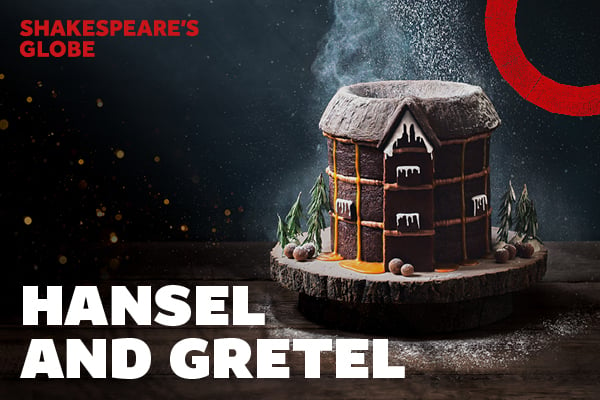Shakespeare's Globe, London
Running time: To be confirmed.
Age Restrictions: To be confirmed.
Tickets from £7.25

Immerse yourself in the enchanting world of Hansel and Gretel, as a new version of The Brothers Grimm’s fairy tale by Poet Laureate Simon Armitage transforms the Globe Theatre with poetry, songs and hope this winter.
When Hansel and Gretel’s parents decide their only option to give their children a better life is to abandon them in the woods, the children must fend for themselves.
Hansel and Gretel’s attempt to get home soon gets side-tracked – quite literally – by a trail of treats too good to resist and a seemingly-sweet stranger with a plan of her own…
Returning with a new recipe of music, mayhem and festive magic, this is a delicious treat for everyone aged 5+ directed by Nick Bagnall (Love’s Labour’s Lost, The Two Gentlemen of Verona, Globe).
Shakespeare's Globe
Shakespeare's Globe
New Globe Walk, Bankside
London
SE1 9DT
Shakespeare's Globe is a is a reconstruction of the Globe Theatre, an Elizabethan playhouse in the London Borough of Southwark on the south bank of the River Thames which was destroyed by fire in 1613. The modern reconstruction was founded by the actor and director Sam Wanamaker and built approximately 230 metres (750 ft) from the site of the original theatre. The theatre was opened to the public in August 1996 with Jack Shepherd's 'Prologue Production' of The Two Gentlemen of Verona starring Mark Rylance as Proteus. The formal opening Gala was held in 1997.
HISTORY OF THE SHAKESPEARE´S GLOBE
The original Globe Theatre was built in 1599 by the playing company, Lord Chamberlain's Men, to which Shakespeare belonged, and was destroyed by fire on June 29, 1613. The fire was caused by an accident with a cannon during a production of Henry VIII. The theatre was rebuilt by June 1614 (the exact opening date is not known), but was officially closed by pressure of Puritan opinion in 1642 and demolished in 1644.
In 1970 American actor and director Sam Wanamaker, founded the Shakespeare Globe Trust, and International Shakespeare Globe Centre with the objective of building a faithful recreation of Shakespeare’s Globe close to its original Bankside, Southwark location. While many had said that the Globe reconstruction was impossible to achieve, he persevered for over twenty years, and eventually a new Globe theatre was built according to a design based on the research of historical advisor John Orrell.
The theatre opened in 1997 under the name "Shakespeare's Globe Theatre" and now stages plays every summer. Mark Rylance was appointed as the first artistic director in 1995 and was succeeded by Dominic Dromgoole in 2006.
The new theatre on Bankside is approximately 230 metres (750 ft) from the original site, centre to centre, and was the first thatched roof building permitted in London since the Great Fire of London in 1666.
As in the original Globe, the theatre has a thrust stage that projects into a large circular yard surrounded by three tiers of steeply raked seating.
The only covered parts of the amphitheatre are the stage and the (more expensive) seated areas. Plays are staged during the summer, usually between May and the first week of October, and in the winter the theatre is used for educational purposes. Tours are available all year round.
The reconstruction was carefully researched so that the new building would be as faithful a replica of the original as possible. This was aided by the discovery of the remains of the original Globe Theatre as final plans were being made for the site and structure. Performances are staged in a manner which is as close as possible to the original environment; there are no spotlights, the plays are staged during daylight hours and in the evenings (with the help of interior floodlights), there are no microphones, speakers or amplification. All music is performed live on period instruments, the actors can see the audience and the audience can see each other, adding to the feeling of a shared experience and community event.
The building itself is constructed entirely of English oak, with mortise and tenon joinery - no structural steel was used. It is, in this sense, an "authentic" 16th century timber-framed building. The seats are simple benches (though cushions can be hired for performances) and the Globe has the first and only thatched roof permitted in London since the Great Fire of 1666. The modern thatch is well protected by fire retardants, and sprinklers on the roof ensure further protection against fire. The pit, however, has concrete flooring as opposed to the earthen ground covered with strewn rush in the original theatre. The "authentic" theatre has extensive backstage support areas for the actors and musicians and is attached to a modern lobby, restaurant, gift shop and visitors' centre for the public. Seating capacity is 857 with an additional 700 "groundlings" standing in the pit, making up an audience about half the size of a typical audience in Shakespeare's time.
Travel by train: Cannon Street. Nearest tube: Mansion House/Cannon Street/London Bridge